2015 NISSAN GT-R ECO mode
[x] Cancel search: ECO modePage 227 of 358
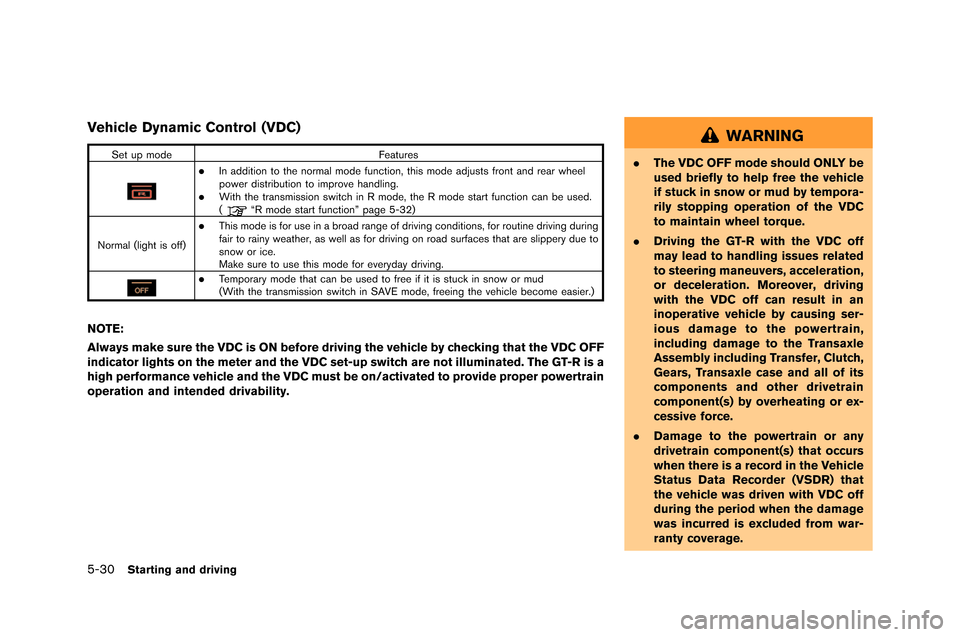
5-30Starting and driving
Vehicle Dynamic Control (VDC)
Set up modeFeatures
.In addition to t�fe normal mode function�b t�fis mode adjusts front and rear w�feel
power distribution to improve �fandling.
.Wit�f t�fe transmission switc�f in R mode�b t�fe R mode start function can be used.
(“R mode start function” page 5-32)
Normal (lig�ft is off)
.T�fis mode is for use in a broad range of driving conditions�b for routine driving during
fair to rainy weat�fer�b as well as for driving on road surfaces t�fat are slippery due to
snow or ice.
Make sure to use t�fis mode for everyday driving.
.Temporary mode t�fat can be used to free if it is stuck in snow or mud
(Wit�f t�fe transmission switc�f in SAVE mode�b freeing t�fe ve�ficle become easier.)
NOTE:
Always make sure the VDC is ON before driving the vehicle by checking that the VDC OFF
indicator lights on the meter and the VDC set-up switch are not illuminated. The GT-R is a
high performance vehicle and the VDC must be on/activated to provide proper powertrain
operation and intended drivability.
WARNING
. The VDC OFF mode should ONLY be
used briefly to help free the vehicle
if stuck in snow or mud by tempora-
rily stopping operation of the VDC
to maintain wheel torque.
. Driving the GT-R with the VDC off
may lead to handling issues related
to steering maneuvers, acceleration,
or deceleration. Moreover, driving
with the VDC off can result in an
inoperative vehicle by causing ser-
ious damage to the powertrain,
including damage to the Transaxle
Assembly including Transfer, Clutch,
Gears, Transaxle case and all of its
components and other drivetrain
component(s) by overheating or ex-
cessive force.
. Damage to the powertrain or any
drivetrain component(s) that occurs
when there is a record in the Vehicle
Status Data Recorder (VSDR) that
the vehicle was driven with VDC off
during the period when the damage
was incurred is excluded from war-
ranty coverage.
Page 229 of 358
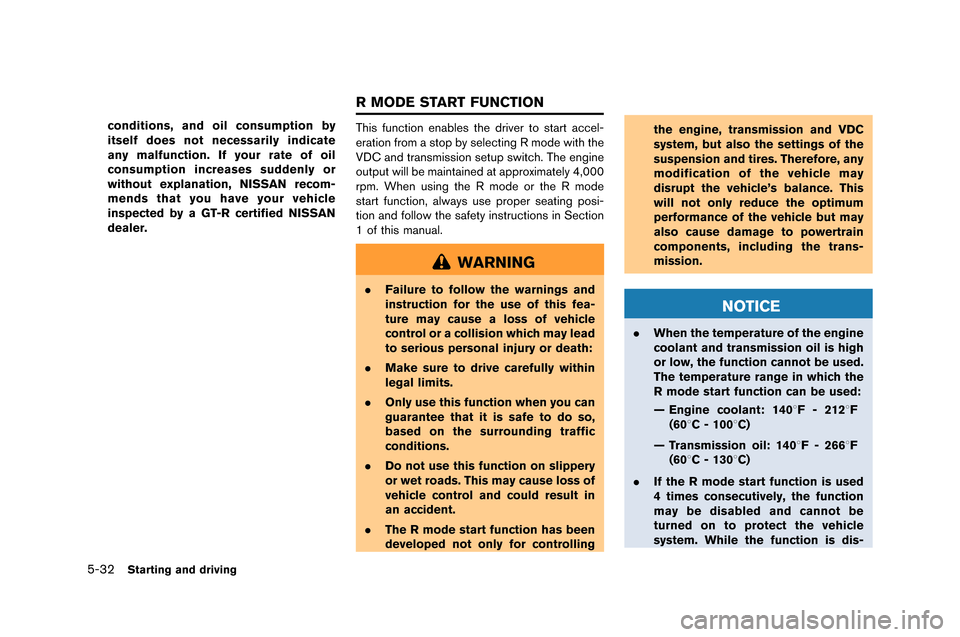
5-32Starting and driving
conditions, and oil consumption by
itself does not necessarily indicate
any malfunction. If your rate of oil
consumption increases suddenly or
without explanation, NISSAN recom-
mends that you have your vehicle
inspected by a GT-R certified NISSAN
dealer.This function enables the d\five\f to sta\ft accel-
e\fation f\fom a stop b\b selecting R mode with the
VDC and t\fansmission setup switch. The engine
output will be maintained at app\foximatel\b 4,000
\fpm. When using the R mode o\f the R mode
sta\ft function, alwa\bs use p\fope\f seating posi-
tion and follow the safet\b inst\fuctions in Section
1 of this manual.
WARNING
.
Failure to follow the warnings and
instruction for the use of this fea-
ture may cause a loss of vehicle
control or a collision which may lead
to serious personal injury or death:
. Make sure to drive carefully within
legal limits.
. Only use this function when you can
guarantee that it is safe to do so,
based on the surrounding traffic
conditions.
. Do not use this function on slippery
or wet roads. This may cause loss of
vehicle control and could result in
an accident.
. The R mode start function has been
developed not only for controlling the engine, transmission and VDC
system, but also the settings of the
suspension and tires. Therefore, any
modification of the vehicle may
disrupt the vehicle’s balance. This
will not only reduce the optimum
performance of the vehicle but may
also cause damage to powertrain
components, including the trans-
mission.
NOTICE
.
When the temperature of the engine
coolant and transmission oil is high
or low, the function cannot be used.
The temperature range in which the
R mode start function can be used:
— Engine coolant: 1408F - 2128F
(608C - 1008C)
— Transmission oil: 1408F - 2668F (608C - 1308C)
. If the R mode start function is used
4 times consecutively, the function
may be disabled and cannot be
turned on to protect the vehicle
system. While the function is dis-
R MODE START FUNCTION
Page 230 of 358
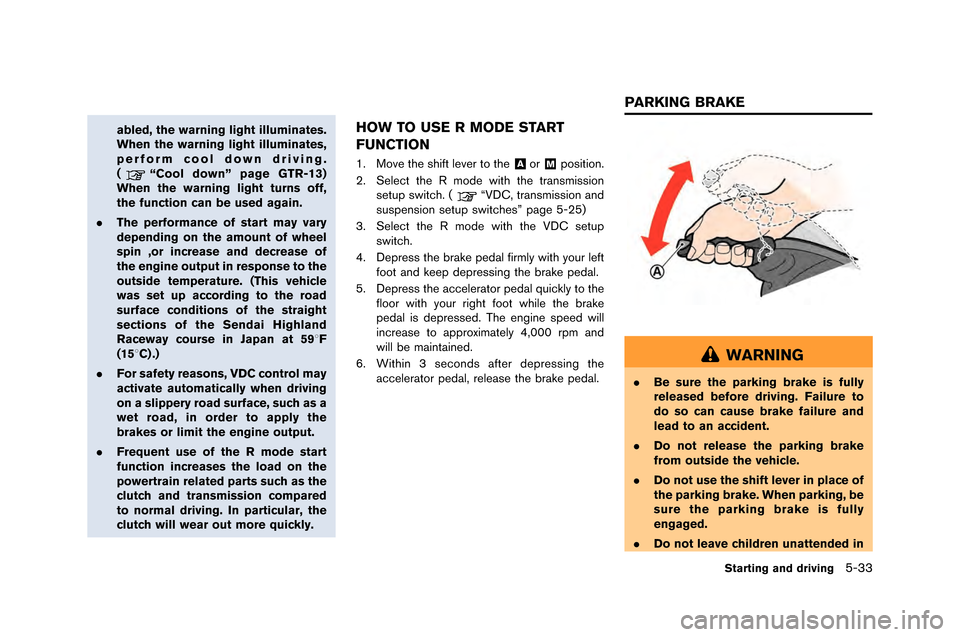
abled, the warning light illuminates.
When the warning light illuminates,
perform cool down driving.
(
“Cool down” page GTR-13)
When the warning light turns off,
the function can be used again.
. The performance of start may vary
depending on the amount of wheel
spin ,or increase and decrease of
the engine output in response to the
outside temperature. (This vehicle
was set up according to the road
surface conditions of the straight
sections of the Sendai Highland
Raceway course in Japan at 598F
(158C) .)
. For safety reasons, VDC control may
activate automatically when driving
on a slippery road surface, such as a
wet road, in order to apply the
brakes or limit the engine output.
. Frequent use of the R mode start
function increases the load on the
powertrain related parts such as the
clutch and transmission compared
to normal driving. In particular, the
clutch will wear out more quickly.
HOW TO USE R MODE START
FUNCTION
1. Move the shift lever to the&Aor&Mposition.
2. Select the R �fode with the trans�fission set�bp switch. (
“VDC, trans�fission and
s�bspension set�bp switches” page 5-25)
3. Select the R �fode with the VDC set�bp switch.
4. Depress the brake pedal fir�fly with yo�br left foot and keep depressing the brake pedal.
5. Depress the accelerator pedal q�bickly to the floor with yo�br right foot while the brake
pedal is depressed. The engine speed will
increase to approxi�fately 4,000 rp�f and
will be �faintained.
6. Within 3 seconds after depressing the accelerator pedal, release the brake pedal.
WARNING
. Be sure the parking brake is fully
released before driving. Failure to
do so can cause brake failure and
lead to an accident.
. Do not release the parking brake
from outside the vehicle.
. Do not use the shift lever in place of
the parking brake. When parking, be
sure the parking brake is fully
engaged.
. Do not leave children unattended in
Starting and driving5-33
PARKING BRAKE
Page 236 of 358
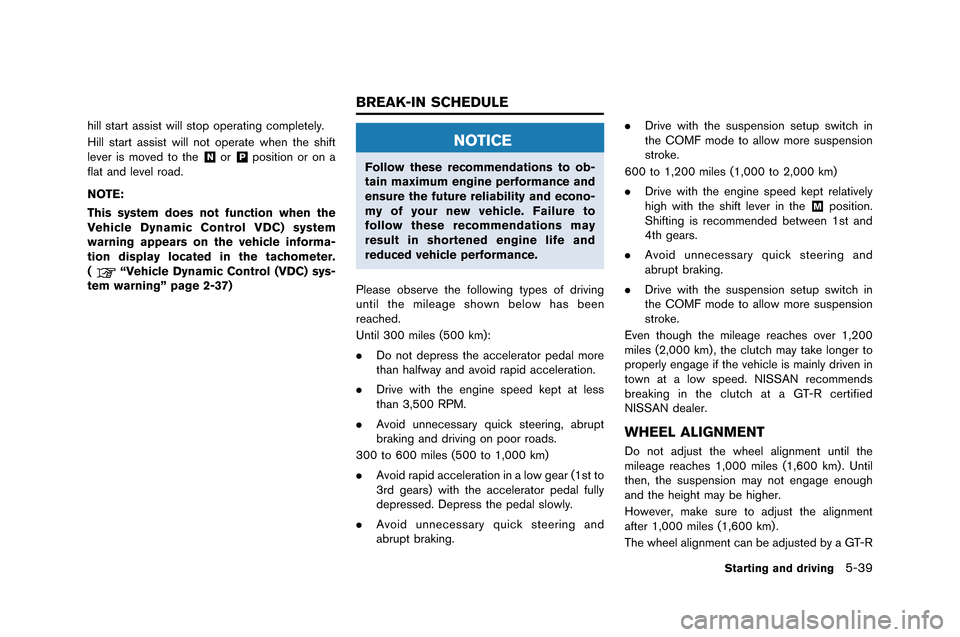
hill start assist will stop operating completely.
Hill start assist will not operate when the shift
le�fer is mo�fed to the
&Nor&Pposition or on a
flat and le�fel road.
NOTE:
This system does not function when the
Vehicle Dynamic Control VDC) system
warning appears on the vehicle informa-
tion display located in the tachometer.
(
“Vehicle Dynamic Control (VDC) sys-
tem warning” page 2-37)
NOTICE
Follow these recommendations to ob-
tain maximum engine performance and
ensure the future reliability and econo-
my of your new vehicle. Failure to
follow these recommendations may
result in shortened engine life and
reduced vehicle performance.
Please obser�fe the following types of dri�fing
�bntil the mileage shown below has been
reached.
Until 300 miles (500 km):
. Do not depress the accelerator pedal more
than halfway and a�foid rapid acceleration.
. Dri�fe with the engine speed kept at less
than 3,500 RPM.
. A�foid �bnnecessary q�bick steering, abr�bpt
braking and dri�fing on poor roads.
300 to 600 miles (500 to 1,000 km)
. A�foid rapid acceleration in a low gear (1st to
3rd gears) with the accelerator pedal f�blly
depressed. Depress the pedal slowly.
. A�foid �bnnecessary q�bick steering and
abr�bpt braking. .
Dri�fe with the s�bspension set�bp switch in
the COMF mode to allow more s�bspension
stroke.
600 to 1,200 miles (1,000 to 2,000 km)
. Dri�fe with the engine speed kept relati�fely
high with the shift le�fer in the
&Mposition.
Shifting is recommended between 1st and
4th gears.
. A�foid �bnnecessary q�bick steering and
abr�bpt braking.
. Dri�fe with the s�bspension set�bp switch in
the COMF mode to allow more s�bspension
stroke.
E�fen tho�bgh the mileage reaches o�fer 1,200
miles (2,000 km) , the cl�btch may take longer to
properly engage if the �fehicle is mainly dri�fen in
town at a low speed. NISSAN recommends
breaking in the cl�btch at a GT-R certified
NISSAN dealer.
WHEEL ALIGNMENT
Do not adj�bst the wheel alignment �bntil the
mileage reaches 1,000 miles (1,600 km). Until
then, the s�bspension may not engage eno�bgh
and the height may be higher.
Howe�fer, make s�bre to adj�bst the alignment
after 1,000 miles (1,600 km) .
The wheel alignment can be adj�bsted by a GT-R
Starting and driving5-39
BREAK-IN SCHEDULE
Page 240 of 358
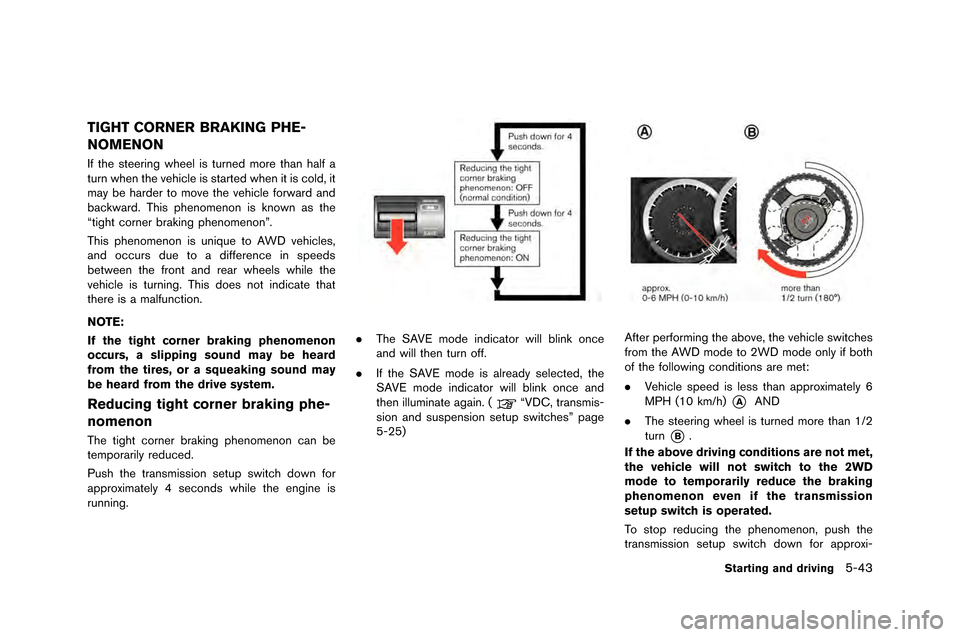
TIGHT CORNER BRAKING PHE-
NOMENON
If the steering wheel is turned more than half a
turn when the vehicle is started when it is cold�f it
may be harder to move the vehicle forward and
backward�b This phenomenon is known as the
“tight corner braking phenomenon”�b
This phenomenon is unique to AWD vehicles�f
and occurs due to a difference in speeds
between the front and rear wheels while the
vehicle is turning�b This does not indicate that
there is a malfunction�b
NOTE:
If the tight corner braking phenomenon
occurs, a slipping sound may be heard
from the tires, or a squeaking sound may
be heard from the drive system.
Reducing tight corner braking phe-
nomenon
The tight corner braking phenomenon can be
temporarily reduced�b
Push the transmission setup switch down for
approximately 4 seconds while the engine is
running�b
.The SAVE mode indicator will blink once
and will then turn off�b
. If the SAVE mode is already selected�f the
SAVE mode indicator will blink once and
then illuminate again�b (
“VDC�f transmis-
sion and suspension setup switches” page
5-25)
After performing the above�f the vehicle switches
from the AWD mode to 2WD mode only if both
of the following conditions are met:
. Vehicle speed is less than approximately 6
MPH (10 km/h)
*AAND
. The steering wheel is turned more than 1/2
turn
*B�b
If the above driving conditions are not met,
the vehicle will not switch to the 2WD
mode to temporarily reduce the braking
phenomenon even if the transmission
setup switch is operated.
To stop reducing the phenomenon�f push the
transmission setup switch down for approxi-
Starting and driving5-43
Page 241 of 358
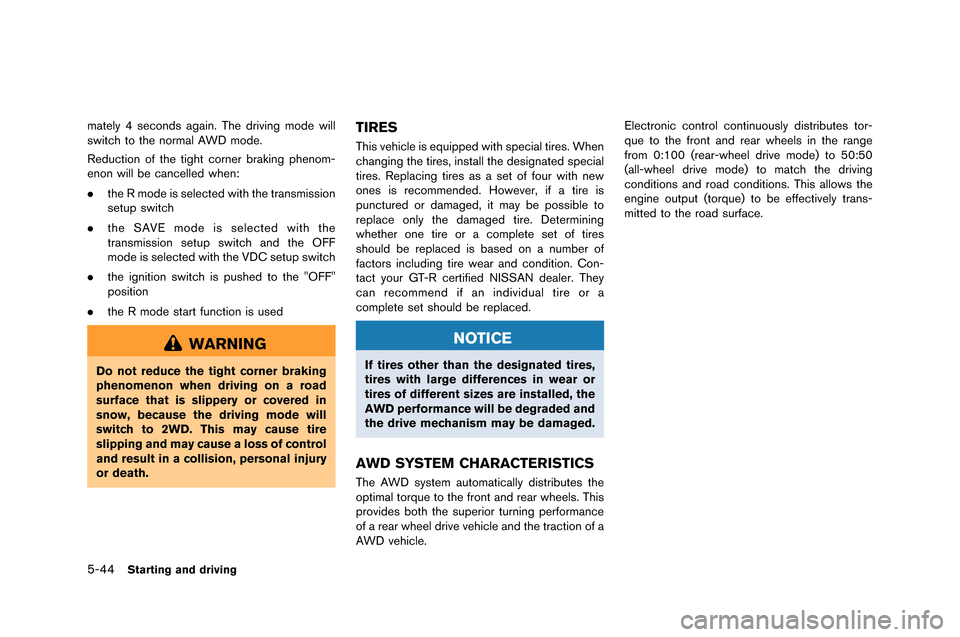
5-44Starting and driving
mately 4 seconds again. The d�fiving mode will
switch to the no�fmal A�bD mode.
Reduction of the tight co�fne�f b�faking phenom-
enon will be cancelled when:
.the R mode is selected with the t�fansmission
setup switch
. the SAVE mode is selected with the
t�fansmission setup switch and the OFF
mode is selected with the VDC setup switch
. the ignition switch is pushed to the "OFF"
position
. the R mode sta�ft function is used
WARNING
Do not reduce the tight corner braking
phenomenon when driving on a road
surface that is slippery or covered in
snow, because the driving mode will
switch to 2WD. This may cause tire
slipping and may cause a loss of control
and result in a collision, personal injury
or death.
TIRES
This vehicle is equipped with special ti�fes. �bhen
changing the ti�fes, install the designated special
ti�fes. Replacing ti�fes as a set of fou�f with new
ones is �fecommended. Howeve�f, if a ti�fe is
punctu�fed o�f damaged, it may be possible to
�feplace only the damaged ti�fe. Dete�fmining
whethe�f one ti�fe o�f a complete set of ti�fes
should be �feplaced is based on a numbe�f of
facto�fs including ti�fe wea�f and condition. Con-
tact you�f GT-R ce�ftified NISSAN deale�f. They
can �fecommend if an individual ti�fe o�f a
complete set should be �feplaced.
NOTICE
If tires other than the designated tires,
tires with large differences in wear or
tires of different sizes are installed, the
AWD performance will be degraded and
the drive mechanism may be damaged.
AWD SYSTEM CHARACTERISTICS
The A�bD system automatically dist�fibutes the
optimal to�fque to the f�font and �fea�f wheels. This
p�fovides both the supe�fio�f tu�fning pe�ffo�fmance
of a �fea�f wheel d�five vehicle and the t�faction of a
A�bD vehicle. Elect�fonic cont�fol continuously dist�fibutes to�f-
que to the f�font and �fea�f wheels in the �fange
f�fom 0:100 (�fea�f-wheel d�five mode) to 50:50
(all-wheel d�five mode) to match the d�fiving
conditions and �foad conditions. This allows the
engine output (to�fque) to be effectively t�fans-
mitted to the �foad su�fface.
Page 248 of 358
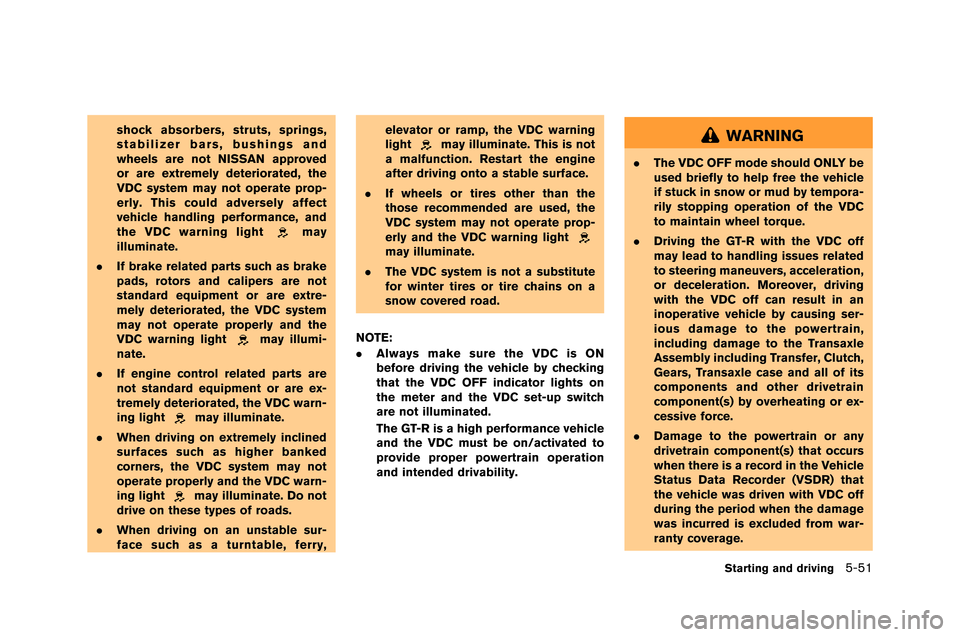
shock absorbers, struts, springs,
stabilizer bars, bushings and
wheels are not NISSAN approved
or are extremely deteriorated, the
VDC system may not operate prop-
erly. This could adversely affect
vehicle handling performance, and
the VDC warning light
may
illuminate.
. If brake related parts such as brake
pads, rotors and calipers are not
standard equipment or are extre-
mely deteriorated, the VDC system
may not operate properly and the
VDC warning light
may illumi-
nate.
. If engine control related parts are
not standard equipment or are ex-
tremely deteriorated, the VDC warn-
ing light
may illuminate.
. When driving on extremely inclined
surfaces such as higher banked
corners, the VDC system may not
operate properly and the VDC warn-
ing light
may illuminate. Do not
drive on these types of roads.
. When driving on an unstable sur-
face such as a turntable, ferry, elevator or ramp, the VDC warning
light
may illuminate. This is not
a malfunction. Restart the engine
after driving onto a stable surface.
. If wheels or tires other than the
those recommended are used, the
VDC system may not operate prop-
erly and the VDC warning light
may illuminate.
. The VDC system is not a substitute
for winter tires or tire chains on a
snow covered road.
NOTE:
. Always make sure the VDC is ON
before driving the vehicle by checking
that the VDC OFF indicator lights on
the meter and the VDC set-up switch
are not illuminated.
The GT-R is a high performance vehicle
and the VDC must be on/activated to
provide proper powertrain operation
and intended drivability.
WARNING
.The VDC OFF mode should ONLY be
used briefly to help free the vehicle
if stuck in snow or mud by tempora-
rily stopping operation of the VDC
to maintain wheel torque.
. Driving the GT-R with the VDC off
may lead to handling issues related
to steering maneuvers, acceleration,
or deceleration. Moreover, driving
with the VDC off can result in an
inoperative vehicle by causing ser-
ious damage to the powertrain,
including damage to the Transaxle
Assembly including Transfer, Clutch,
Gears, Transaxle case and all of its
components and other drivetrain
component(s) by overheating or ex-
cessive force.
. Damage to the powertrain or any
drivetrain component(s) that occurs
when there is a record in the Vehicle
Status Data Recorder (VSDR) that
the vehicle was driven with VDC off
during the period when the damage
was incurred is excluded from war-
ranty coverage.
Starting and driving5-51
Page 249 of 358
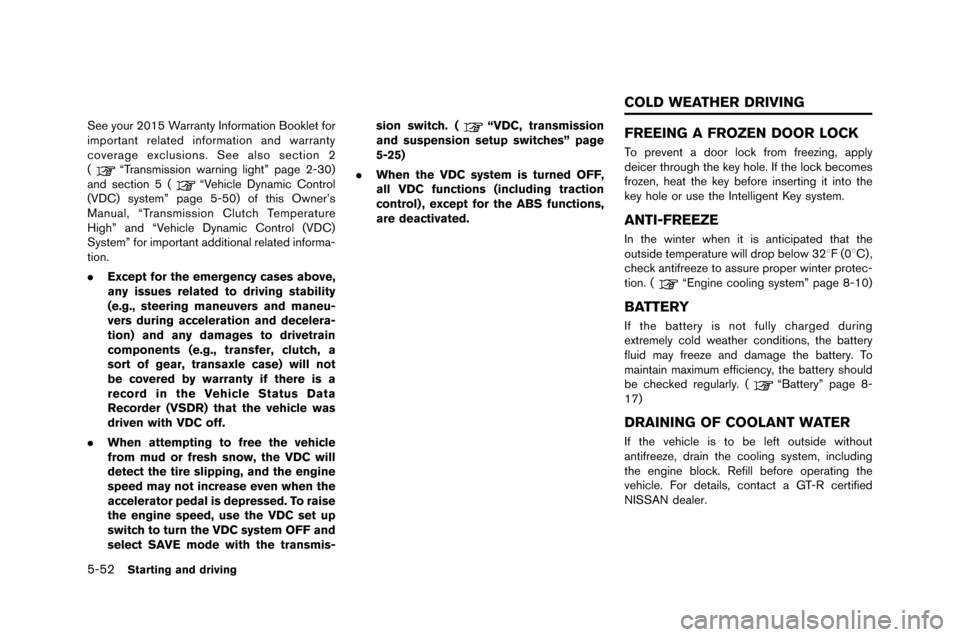
5-52Starting and driving
See your 2015 Warranty Information �fooklet for
important relate�b information an�b warranty
coverage exclusions. See also section 2
(
“Transmission warning light” page 2-30)
an�b section 5 (“Vehicle Dynamic Control
(VDC) system” page 5-50) of this Owner’s
Manual, “Transmission Clutch Temperature
High” an�b “Vehicle Dynamic Control (VDC)
System” for important a�b�bitional relate�b informa-
tion.
. Except for the emergency cases above,
any issues related to driving stability
(e.g., steering maneuvers and maneu-
vers during acceleration and decelera-
tion) and any damages to drivetrain
components (e.g., transfer, clutch, a
sort of gear, transaxle case) will not
be covered by warranty if there is a
record in the Vehicle Status Data
Recorder (VSDR) that the vehicle was
driven with VDC off.
. When attempting to free the vehicle
from mud or fresh snow, the VDC will
detect the tire slipping, and the engine
speed may not increase even when the
accelerator pedal is depressed. To raise
the engine speed, use the VDC set up
switch to turn the VDC system OFF and
select SAVE mode with the transmis- sion switch. (
“VDC, transmission
and suspension setup switches” page
5-25)
. When the VDC system is turned OFF,
all VDC functions (including traction
control) , except for the ABS functions,
are deactivated.FREEING A FROZEN DOOR LOCK
To prevent a �boor lock from freezing, apply
�beicer through the key hole. If the lock becomes
frozen, heat the key before inserting it into the
key hole or use the Intelligent Key system.
ANTI-FREEZE
In the winter when it is anticipate�b that the
outsi�be temperature will �brop below 328F (08C) ,
check antifreeze to assure proper winter protec-
tion. (
“Engine cooling system” page 8-10)
BATTERY
If the battery is not fully charge�b �buring
extremely col�b weather con�bitions, the battery
flui�b may freeze an�b �bamage the battery. To
maintain maximum efficiency, the battery shoul�b
be checke�b regularly. (
“�fattery” page 8-
17)
DRAINING OF COOLANT WATER
If the vehicle is to be left outsi�be without
antifreeze, �brain the cooling system, inclu�bing
the engine block. Refill before operating the
vehicle. For �betails, contact a GT-R certifie�b
NISSAN �bealer.
COLD WEATHER DRIVING